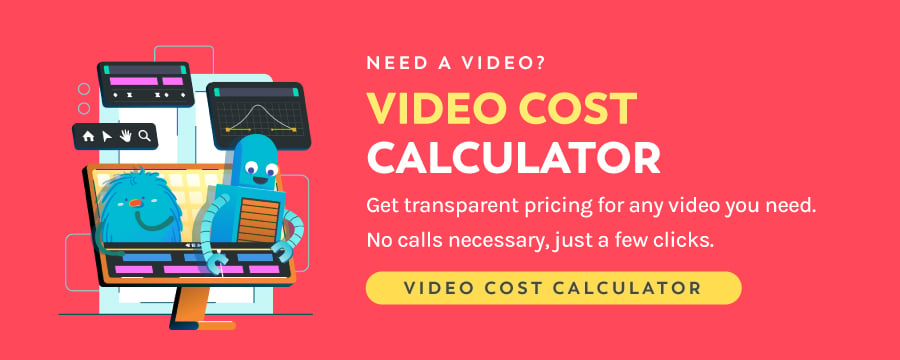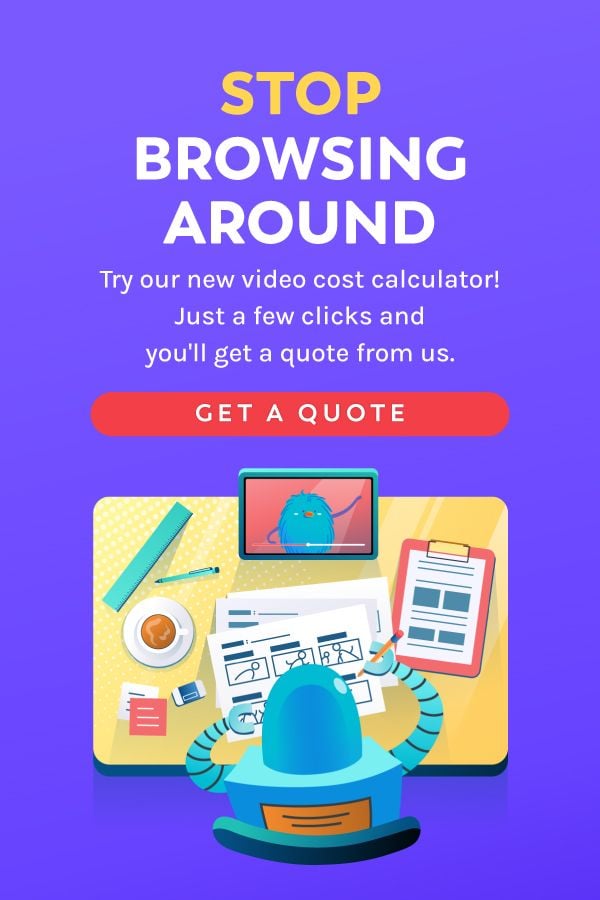Table of Contents ×
- 1 How Do You Make An Explainer Video?
- 1.1 1. Essential Preparation of Video Production Process: Map Out the Production
- 1.2 2. Starting Explainer Video Production Process: Initial Script
- 1.3 3. Formulate a Company Branding
- 1.4 4. Mockup Phase: Build People’s Character
- 1.5 5. Creating a Storyboard
- 1.6 6. Sound in Video: Background Music and Voice-over
- 1.7 7. Animation: The Core Business
- 2 Issues That May Occur During the Video Production Process
- 3 Explainer Video Production Process In a Nutshell
- 4 Final Words: Start Your Video Production Process
People may think that the explainer video production process is quite straightforward. Especially with the rise of AI.
The reality is different. Explainer video production is complex, from discussing with clients, deciding on concepts, and creating a storyboard to achieving business goals.
After years of running our animated explainer video company, we hope you can appreciate this step-by-step we have put together.
Although your video company has a great animation team, creating quality content takes time. That’s because you need to ensure vital points before handing the final product to the client, which include:
- Clear and easy-to-understand messages
- High-quality motion graphics
- Engaging narration
- Quality explainer video music, and sound effects
- Likable characters
Each step can go wrong, which is precisely why professional video marketing services can be expensive.
However, given how they can attract new customers and impact your company, it is one of the best ways to improve your business.
The following discussions can tell you about the explainer video process.
Keep reading!

How Do You Make An Explainer Video?
Below are the essential steps in Breadnbeyond’s video production process. The process may be stretched or shortened depending on various factors, such as the project’s urgency.
1. Essential Preparation of Video Production Process: Map Out the Production
The first thing to do in an explainer video production is plan the whole production itself.
This is the phase where you map out everything—the ideas, goals, budget, target audience, message, and strategy. These are the lifeblood of the production, so the more time you spend on this phase, the smoother the entire process will be.
The decisions you make in this phase will cascade throughout the production.
Therefore, taking your time, collecting inspiration, and generating ideas is always better.
Since your video needs to stand out from the crowd, try coming up with unconventional ideas and combining them into tasteful plans.
Overall, the planning phase mostly includes:
Set Your Explainer Video Goals
You don’t put extra effort into your explainer video marketing without specific goals you want to achieve, do you?
Without goals, your explainer video production will undoubtedly lack focus and direction.
To include video in your marketing mix just for the sake of doing it doesn’t yield precise results.
Ask yourself, “What do I want to accomplish with this explainer video production process?”
Do you want to increase your web traffic? Engage more customers? Raise brand awareness?
The more specific goals you set, the higher your chances of achieving them.
Once you narrow your goals, you can measure the video’s impact and hand-pick the strategy until you find the best fit for your business.
One thing that most marketers often forget is that they set too many goals for a video.
Consequently, their message becomes vague and all over the place, confusing their audience.
Understand Your Target Audience
Understanding your target audience is essential in producing a successful explainer video, yet marketers are unaware of it.
It is nearly impossible to reach everyone online and meet each customer’s requirement with your video. That is why narrowing the focus to a core audience is crucial.
Who are they?
Where are they?
What do they like?
What do they value?
Those four basic questions will give you insights into pinpointing and understanding your target audience better. They will also help make your production more cost-effective.
Rather than being concerned about what your product or service does, think about how it solves your target audience problem.
This is where you need to put yourself in your target audiences’ shoes and build your buyer persona.
The more you understand your target audience, the more you develop a strong emotional connection with them.
Do you know what will happen if you have a personal connection with your customers? They’ll stick around.
Determine Your Core Message
Now that you understand your target audience determining the core message you want to deliver is the next step.
Your challenge is brainstorming what story or message you’ll include in the explainer video.
Determining your core message is all about connecting with your target customers so that they can seamlessly take your desired action.
Do you want them to visit your social media? Or do you want them to purchase your product?
For an explainer video to hit home, you don’t have to talk about your product for the entire video.
Hence, it is essential to use characters and a storyline your target audience can relate to. This will evoke their emotions, making it easier for them to recall your brand.
That’s how you determine your core message.
Remember to keep it clear, short, and snackable— under three minutes.
You sure know your audience doesn’t have all day to absorb your messages, right?
A longer video duration can make your message unclear and boring, and there they go…lost customers!
Build Your Video Production Process Strategy
Goal? Set.
Target audience? Spot-on.
Core message? Check.
Your explainer video is almost ready, and what’s left is maximizing its impact.
Now, the task is to build a winning video content strategy.
With millions of hours of videos uploaded to the Internet every second, you need to make extra effort to make your brand stand out among the crowd.
It might seem a harsh and painful process but don’t tremble.
With a winning, overarching strategy, it’s much easier for you to outsmart the competition.
First and foremost, start with knowing what your competitors are doing.
Observe their goods and no-goods strategies, and turn their weaknesses into your power.
It’s a smart tactic to outsmart them.
It would take us all day to discuss video strategies. Fortunately, our team has outlined a video marketing checklist to help you map out your video strategy.
Create a Video Production Brief
You combine all of those steps in the planning phase to create a video brief as a guide before the entire explainer video production.
You can refer to your video production brief to get the solution whenever there is a concern, lost focus, uncertainty, or question.
With a video production brief, you can seamlessly maintain the essence of your explainer video production in a clear working outline.
It helps you assess what you want and need during and after the production.
Having a clear video production brief makes the production run smoothly and ensures that the video’s outcome meets your marketing objectives.
2. Starting Explainer Video Production Process: Initial Script
Before we get into the script and storyboard, the first task is to establish a creative approach to meet all the requirements of your explainer video production process.
Why does it matter?
It matters because it’s crucial to outsmart your competitors and make your product stand out with creativity.
As you already know, explainer video production’s fun part is using your creativity.
This is it. This is the part that requires your creativity.
At its most basic level, the creative approach draws insights from the production brief.
It includes what you need to include in the production, how you present it, and how to make it remarkable.
Now, move on to the script writing.
The script represents the core of your video. It will guide the character-making, storyboarding, and animating processes.
Even though visuals and sound effects are significant for conversion, a proper script may be needed to achieve business goals.
Explainer videos have short time frames ranging from 15 seconds to two minutes. That’s why you should carefully count how many words you write.
In our study on how many words an explainer video should have, we found that a 60-second video should have between 160 and 180 words per minute.
In addition, a 60-second video should have anywhere between 160-180 words per minute.
Focus on conveying vital messages, such as the benefits of your products or services. This will make your message more understandable to audiences.
Here’s a quick pro tip: it’s not about what you want to say to your audience; it’s all about how you make them relate to the story you tell.
That is the smart way to win their hearts.
Thus, you can call it a compelling script if it relates to your audience and motivates them to take action.
A compelling script doesn’t have to be complicated., but it has to be short and snackable. You’re writing a script, not a novel.
All you need to do is evoke their emotions by addressing your target audiences’ problems from the start and offering an end-to-end solution at the end.
Your script will also influence the scenes and video graphics the audience will see. It will also guide you in developing the video storyboard later.

3. Formulate a Company Branding
Branding is another aspect that should be considered during the initial phases, as it can dictate the direction you take.
You should account for it while writing the script.
Consider how your brand and products will fit into the explainer video.
For example, the color palette will have the best impact. You can also use the same font used on your website. Adding the brand logo in the background will be an additional benefit.
Align explainers with the other forms of content. For example, if you want to include scientific results, it is better to incorporate formal language and simple visualizations.
Although explainer videos let you diversify your content and try out new things, stay moderate, as this can alienate your loyal fans.
4. Mockup Phase: Build People’s Character
The creative team will choose the visual style and build characters during the mockup phase. This stage marks the start of a video production. You can choose one explainer video style, such as:
- 3D
- Whiteboard animation
- Motion graphic animation
- Kinetic typography animation
- Silhouette animation
- Motion graphics and so on.
When it comes to the characters, you should create a persona your audience can identify with. Here’s a sample of our mockup slides:

This phase is crucial for branding. Make sure to find something that suits your brand needs and image. For example, motion graphics are suitable for IT companies, while whiteboard style is suitable for “static” industries.
If your clients struggle to choose a suitable style, they can study competitors on social media. They can use the same style as competitors or choose a different one to stand out in the market.
Although most animation companies have a portfolio with potential ideas, many clients will have their own vision. Communication will be necessary during this phase to help service providers satisfy their clients.
5. Creating a Storyboard
Now, it’s time to put your drawing skills into practice in designing a storyboard.
Don’t worry; even if you think you’re still struggling to draw a straight line, you’ll always be able to design it. No,w there are many software tools you can use to create your storyboard digitally.
A storyboard will bring a message to life if a script conveys a vital message. As the name implies, a storyboard shows individual slides using the script to describe an action happening within them.
It’s necessary to help you to visualize your script before you do a single shoot.
Not to mention that it also points out the inconsistencies in your script and finalizes it.
It looks like a comic strip. Each square shows who or what will be on the screen and what they will say. It also includes information on how the entire video will play out and appear visually.
Try to imagine what the final result of your explainer video will be.
What is the lighting setup going to be like?
What angle fits best?
What text you’d put on the screen?
While you read your storyboard, you should be able to see the final results of your explainer video playing in your head.
Here’s one of the storyboards we made:

In essence, a storyboard is a visual blueprint or master plan. It is a mix of motion, transitions, and shots.
The creative team creates the storyline with visuals, adding animation, graphics, and illustrations. They often also add motion cues to objects.
Like with a mockup, it is much better if the client creates the video concept and storyline. It is a perfect time to exchange ideas.
6. Sound in Video: Background Music and Voice-over
Adding music or a soundtrack can bring your explainer video to life. They help stimulate your target audience’s emotions and evoke their mood.
Simply put, it gives your video a personality.
Do you want your target audience to feel emotional after they watch your explainer video?
Or do you want them to feel inspired?
Maybe you want them to feel joyful?
You can play around with music and sound effects to give a certain vibe to your explainer video.
Meanwhile, you might as well need a voice-over.
Explainer videos commonly include voice-overs to narrate the content. Compelling scripts for the voice narrations helps engage audiences optimally.
In most explainer video production companies, as soon as the client approves the script, the voice-over actor can start working on the project and finish the voice recording within a reasonable time (usually within 24 hours).
However, if you want to record your voice-over yourself, you can use some voice-over tools to streamline the process.
The voiceover artists’ various styles, tones, and accents make your explainer video more alluring than relying on the visuals and background music alone.
Explainer companies have numerous actors at their disposal, and depending on companies’ preferences (regarding the desired voice type), it is easy to find the right fit.
7. Animation: The Core Business
In this process, you will have the visual elements and are ready to put them in motion. It is also the most demanding task for the creative team and takes up most of the project time.
The quality of the final video will be most affected by digital equipment and users’ skills.
Moreover, we have to deal with sound effects and background music.
Music is crucial in setting the mood. While characters in a video can express emotions, the music depicts these emotions to the audience. It is also an essential tool for leading the audience.
Music is the best way to set up a mood. You can add dynamic music to evoke excitement or slow-paced to give a luxurious vibe. In addition to sound effects and pieces of music, consider adding more features like subtitles.
Check out our article on explainer video tools for more information.
Issues That May Occur During the Video Production Process
The two main issues that may occur during the project are:
- The client is not satisfied with the final product
- The process takes too long to finish
Whether or not the client will be satisfied with the product depends on the client and the video company. Most explainer services have a portfolio or a presentation to give clients ideas about the outcome.
The issue usually occurs due to a lack of communication and involvement. The production process is tricky, and optimal results require a client’s participation during various stages. Good communication is also necessary.
On the other hand, the video production process can take longer than expected. Complex concepts, client demands, and inadequate resources can be the underlying reasons for this problem.
On average, the production process can take several days up to a week. The process also ensures that the final video is high-quality and meets the client’s demands.
Explainer Video Production Process In a Nutshell
Look at the infographic below to help you understand the explainer video production process. This is our basic explainer video workflow at Breadnbeyond, our studio.
Not all explainer video production companies have the same approach, but this gives you a solid idea of how we bring stories to life from script to screen.
<div style="clear:both"><a href="https://breadnbeyond.com/articles/video-production-process/" target="_blank" rel="noopener"><img src="https://breadnbeyond.com/wp-content/uploads/2020/11/Breadnbeyond-Workflow-Video-Production-Process-scaled.jpg" class="img-embed" title="Essential Steps of an Explainer Video Production Process" alt="Essential Steps of an Explainer Video Production Process" width="1280" height="2560" border="0"/></a></div><div>Courtesy of: <a href="https://breadnbeyond.com" target="_blank" rel="noopener">Breadnbeyond</a></div>Every team member has their duties and responsibilities. With all those long steps and painstaking efforts in production, they must work harmoniously to produce stunning, high-performing explainer videos for clients.
Final Words: Start Your Video Production Process
The entire process of making an explainer video requires the role of the company and the client. To make the project successful, you need to discuss personal preferences.
It is also a complex process requiring keen attention to detail, so you must be careful when choosing a service provider.
Explainer videos can be better marketing tools than other promotional videos because they provide valuable content. They also effectively attract visitors, diversify content, and propel your website to a new level.
At Breadnbeyond, we offer an excellent service and various animated explainer video packages tailored to boost your sales in the next campaign. Click on the banner below!



